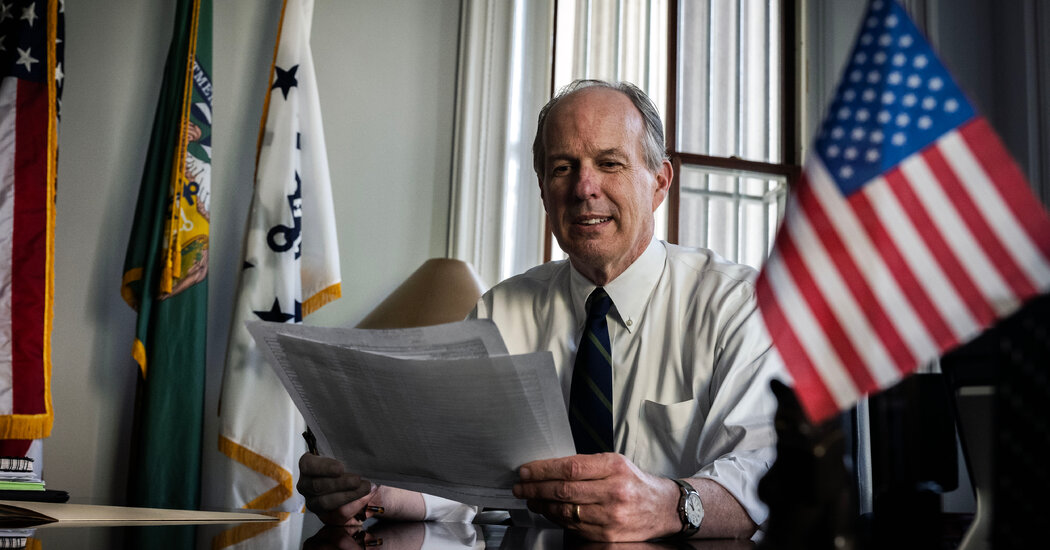Shoppers and businesses are bracing for higher prices when tariffs on Mexico and Canada go into effect on Saturday
What will Congress tell us after Trump does? Senator Ben Lutnick’s Legacy after the Sept. 11, 2001, Revealed in a House of Representatives
Before taking the Cabinet position, Lutnick would have to give up all of his assets to avoid financial conflicts of interest. He previously disclosed stakes in at least 800 firms and legal entities. It’s unclear whether Lutnick might sell his assets to his adult children.
Vice President Vance described the man he introduced as a personal friend, a good dude, and a wildly successful businessman. Senators praised Lutnick’s resilience after the death of both his parents at his young age and his fundraising to support the families of his colleagues who died in the Sept. 11 attacks.
“If President Trump asks you to cut infrastructure funding that has been passed by Congress in a bipartisan fashion, will you oppose that?” asked Ben Ray Lujn.
“If President Trump ordered you to steal funds that were given to you by Congress, would you do it?” asked the senator.
Even if President Trump directs him not to, many Democrats want him to commit to dispersing federal subsidies for broadband access. According to him, his goal was to give Congress the benefit of the bargain, by ensuring programs were efficient and effective.
The CHIPS Act was the focus of most of the hearing and was meant to revive America’s Semiconductor Manufacturing industry, now dominated by Taiwan, South Korea and China. Trump has panned the program as wasteful, and Lutnick called it “an excellent down payment” that still needed to be reviewed to get it right.
He accused China of “leveraging what they’ve taken from us, stolen from us” to develop its groundbreaking DeepSeek chatbot, arguing that export controls on technology should be combined with stricter tariffs. The government’s use of artificial intelligence tool will make it harder for criminals to use the ledger for illegal activity, according to Mr. Lutnick.
Several lawmakers asked Lutnick about rising costs for both U.S. companies and consumers — especially if other countries retaliate with tariffs of their own on American exports.
In November, Mr. Trump said he would impose 25% tariffs on Canada and Mexico, 10% on China, and a further 5% on other countries to stop the flow of migrants into the United States.
“We need that disrespect to end, and I think tariffs are a way to create reciprocity, to be treated fairly, to be treated appropriately,” Mr. Lutnick said.
But, Lutnick repeatedly argued, the world has treated the U.S. with disrespect; that includes China but also allied nations in Europe, Canada, Japan and Korea, taking advantage of “of our good nature” to grow their own economies.
He extolled the virtues of the United States, saying it has the best farmers, fishers and ranchers in the world, and is home to the world’s greatest land.
Howard Lutnick, the billionaire Wall Street CEO, fielded questions about tariffs’ impact on U.S. manufacturers and farmers, federal funding for broadband access, China’s progress on artificial intelligence and reviving American domestic mining, logging and semiconductor production.
Implications of Trade Triggers on American Imports and Demand for Higher-Order U.S. Customs and Excise Rates
The Commerce Department is responsible for imposing tariffs on imported goods and granting exemptions from those taxes. The Commerce Secretary negotiates trade deals, promoting U.S. businesses and exports. The department also includes the National Oceanic and Atmospheric Administration with the National Weather Service, the Census Bureau and the National Telecommunications and Information Administration, which focuses on the use of wireless airwaves and broadband access.
Ernie Tedeschi, the director of economics at the Yale Budget Lab, estimates that a 25 percent tariff on all Canadian and Mexican imported goods — paired with a 10 percent tariff on all Chinese imports — would lead to a permanent 0.8 percent bump in the price level, as measured by the Personal Consumption Expenditures price index. That translates to roughly $1,300 for households on average. The Federal Reserve does not adjust interest rates and the targeted countries retaliate, according to the estimates.
Mr. Lutnick indicated that he believed “across the board” tariffs on countries would be most effective, arguing that China should face the highest rates and that Europe, Japan and South Korea were also treating American industries unfairly.
Over time, economists are concerned about how trade tensions might affect growth, with warnings of less investment, slower growth and more subdued business activity.
They will immediately raise costs if they bring products across the border. In the nearer term, that could disrupt supply chains and lead to product shortages, if importers choose not to pay the cost of the tariff. And in the longer run, companies may choose to pass the tariff cost on to American consumers, raising prices and slowing the economy.
The Federal Reserve is trying to wrestle inflation down to its 2 percent target, which is complicated by the economic implications of tariffs. The Fed this week held interest rates steady, after a series of cuts, amid persistent inflation and questions about how the tariffs would play out.
According to Tom Kloza, the global head of energy analysis at Oil Price Information Service, if fuel producers respond to the tariffs by cutting production, gasoline prices in the Midwest could climb 15 to 20 cents a gallon, with more muted effects in other parts of the country.
The United States is the world’s largest oil producing country, but refining needs to mix heavier oil from places like Canada and other places to make fuels like gasoline and diesel. Canada and Mexico provide about 7 percent and 60 percent of the US’s oil imports.
He said that the tariffs might not apply to oil imports, a proposal that could potentially prevent a spike in gas prices.
The tariffs on Canada will be announced for a number of reasons. “I’ll be putting the tariff of 25 percent on Canada, and separately, 25 percent on Mexico, and we’ll really have to do that.”
Trudeau reiterated on Friday that his government didn’t know if tariffs would be in place on Saturday and what they would cover.
The Mexican and Canadian officials made a last-minute effort to keep tariffs from being imposed by the administration, after hearing of the threat, by engaging in talks with the Secretary of State.
In a press briefing Friday, White House press secretary Karoline Leavitt said the president would implement on Saturday a 25 percent tariff on goods from Mexico, a 25 percent tariff on goods from Canada, and a 10 percent tariff on goods from China.
Mr Trump wants to hit allies with tariffs over issues that have nothing to do with trade and his focus on illegal immigrants shows how he will use economic tools to fulfill his domestic policy agenda.
Businesses and shoppers in the U.S. are bracing for higher prices on everything from gasoline to guacamole, as President Trump renews his threat to impose steep tariffs this weekend on imports from two of the country’s biggest trading partners.
While the size and scope of the tariffs is still uncertain, many businesses are making contingency plans. Trade data released on Wednesday showed a sharp rise in imports in December, suggesting some companies tried to stockpile goods before any tariffs take effect.
“Importers were trying to bring in goods ahead of time,” says Matthew Martdin of Oxford Economics. There are costs and risks to keeping inventory. Businesses clearly think there will be enough demand to keep this inventory on hand for a long time.
Individual shoppers attempted to beat the tariffs. The figures released Friday by the Commerce Department show that spending on durable goods went up in December. Mexico produces flat-screen TVs.
General GM told analysts on Tuesday that it could shift some pickup truck production out of Canada and Mexico if tariffs are imposed. But the automaker is reluctant to act while the trade landscape is still uncertain.
The Effect of Increasing Expenses on U.S. Consumers’ Electricity Consumption and Other Organizations’ Core Problems
“Increasing expenses by 25% is going to lead to higher costs at the pump for U.S. consumers and higher input costs for businesses around the country,” Martin said.

